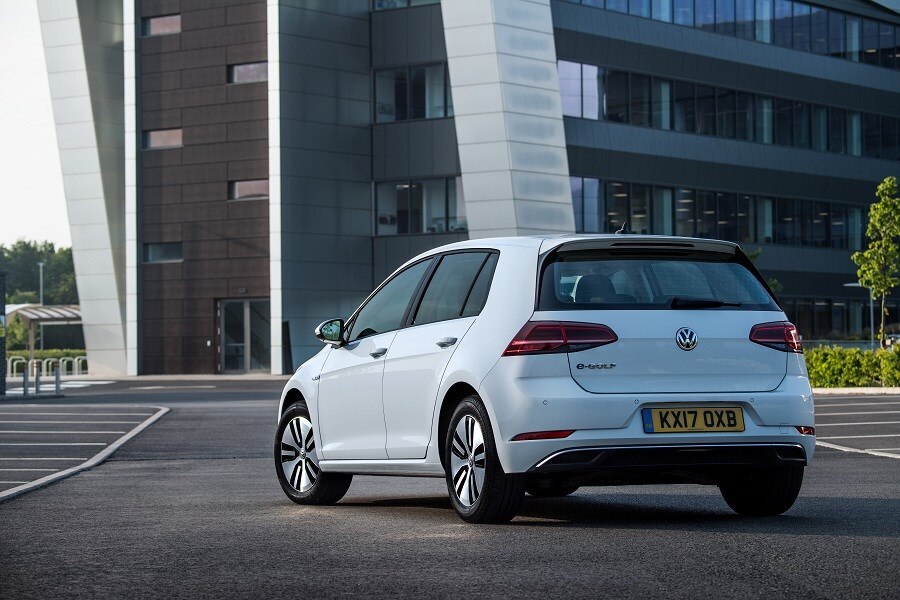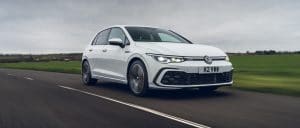Section: Model Review
The Golf is probably Volkswagen’s most recognisable model, having been on sale for over 45 years in the UK. Now in its seventh generation, the Volkswagen Golf has moved on from its humble beginnings but remains as popular as ever—in fact it was the UK’s second best-selling car in 2018, behind Ford’s Fiesta.
The seventh-generation Golf marked the first-ever all-electric version of the famous model, dubbed the e-Golf. It is not that dissimilar to a conventionally powered Golf in terms of looks, aside from the distinctive LED daytime running lights at the front, and a special alloy wheel design.
Volkswagen also offers a plug-in hybrid version of its Golf – the GTE – for those who aren’t ready to make the jump to a fully electric car just yet.
Latest model
A facelift version of the Volkswagen Golf—dubbed the MK7.5—was brought out at the start of 2017 and a duly updated e-Golf hit showrooms in the third quarter of the same year.
The main difference to the refreshed e-Golf was an increased range. In its new guise, it was capable of a more practical 186 miles, which was up from 118 miles on the pre-facelifted car thanks to an increase in battery size. Power and torque also saw an increase by 21bhp and 20Nm respectively.
Alongside the updates the standard facelift model received, the e-Golf now features more tech than ever before. This includes a 9.2-inch touchscreen with gesture control, as well as new safety assists such as front assist and an extension of its City Emergency Braking system that can now detect pedestrians moving across the vehicle’s path.
Value for money
The e-Golf is considerably more expensive than a similarly-powered petrol or diesel model, although this is the case for most electric cars. The £33,240 starting price is expensive, although it seems slightly cheaper with the £3,500 electric government grant applied.
It also comes with an impressive list of standard equipment including full LED headlights and rear lights, front and rear parking sensors, plus a 9.2-inch touchscreen with Apple CarPlay, Android Auto and satellite navigation.
The e-Golf has not proved to be that popular so far, which means that there are a rather limited number for sale on the used/pre-owned market. Because of this, values are quite hard to gauge. We could find only one pre-facelift car for sale—an early 2014 model with 20,000 miles on the clock with a price tag of £16,000. This appeared to be good value for money, and also showed that they have held onto their value well.
If you want to stick to the enhanced, refreshed version of the car, there are still savings to be had. The cheapest facelifted car we could find was priced at £22,000, and a handful of six-month-old examples at £25,000 seemed like great value for money.
Looks and image
The e-Golf largely retains the good elements of the standard Golf. It is refined, well-built and has a wonderful interior.
We also like the way it looks, particularly its distinctive light bar that spans the full length of the front bumper. The unique alloy wheels also help to subtly differentiate the e-Golf from the standard version of the German hatchback.
The interior is also as classy as ever, with the fantastic 9.2-inch touchscreen being the main focal point. The rest of the cabin is made up of high-quality materials and appears to have been perfectly assembled. Blue accents throughout the cabin are another nice touch exclusive to the e-Golf.
It doesn’t feel all that different to drive compared to a normal Golf, with the only noticeable difference being a firmer ride. This is because the suspension has been stiffened to cope with the extra weight of its batteries. While its handling rarely feels different to the regular Golf, the ride is rather fidgety on urban roads but again, this is because of the additional weight.
On the move, it’s even quieter than the standard Golf thanks to the lack of engine drone. It’s not the most comfortable, though, as the differences in suspension, wheel, and tyre set up rear their ugly heads on a fairly regular basis. Even with these grumbles accounted for, it remains one of the most refined electric cars on sale.
However, this disappointment is somewhat offset thanks to a plentiful scale of seat and steering wheel adjustment, allowing practically anyone to find a good driving position.
Space and practicality
Compared to some electric cars, the e-Golf really isn’t much less practical than its ‘regular’ counterpart. The main difference is the reduced boot space—with 342 litres of capacity in the e-Golf compared to 380 litres in the standard car. This is due to battery storage raising the floor of the boot.
Passenger space remains the same, though. This means there is plenty of room in the front and back, while legroom has also been increased on the facelifted version. It would be a squeeze to get three adults in the rear, but that can be said for any hatchback of this size.
It’s also worth mentioning that Volkswagen doesn’t regard its e-Golf as suitable for towing.
The Golf is a very safe car and was awarded five stars when it was tested by Euro NCAP. It’s even safer now thanks to extra safety technologies such as front assist—a system that can slow the car or stop it entirely if it senses that an incident is imminent. It also features city emergency braking and stability control.
As a family car, the e-Golf is ideal. Yes, the boot space might be a bit smaller than its petrol and diesel counterparts, but it remains flexible, spacious and secure.
Power and range
Just one battery option is available on the e-Golf—a 35.8 kWh unit. It produces the equivalent of 134bhp and 290Nm of torque. It’s limited to a top speed of 93mph, although its 0-60mph time of 9.4 seconds is good. Power is delivered through a single-speed transmission.
The range on the e-Golf is a claimed 186 miles, although Volkswagen admits it’s more likely to manage just 125 miles in real-world conditions. This figure is a little disappointing when compared to cheaper rivals such as the Renault Zoe and new Nissan Leaf, both of which can go much further on a single charge.
As for charging times, you can expect it to go from empty to 80 per cent charge in just 45 minutes when you use a fast-charger. Using a wall box to charge it to full will take five hours and 20 minutes, while it will take 13 hours using a domestic three-pin plug socket.
Running costs
The running costs of the e-Golf are impressive. Because it doesn’t emit any CO2, you won’t have to pay any road tax, while it will also be exempt from many emissions-based road fees, such as the London Congestion Charge.
It will also make a lot of sense for business users, particularly as it sits in the lowest benefit-in-kind category. By choosing an e-Golf over a diesel-powered Golf GTD, you could pay almost two-thirds less in business car tax.
As for insurance groupings, the e-Golf is placed in group 20. This makes it comparable with the BMW i3.
Things to look for
The Volkswagen Golf has proven itself to be a reliable car, and scores a consistently high grade in reliability surveys. Its build quality is also superior to that of its rivals—bar the BMW i3—so you should have nothing to worry about on that front.
As so few e-Golfs have been sold, it is hard to know whether it has had any common problems, but it is likely to be just as reliable as the petrol and diesel versions.
Rivals
The e-Golf’s main rivals are the Nissan Leaf, BMW i3, Hyundai Ioniq and Kia Soul EV. The Renault Zoe could also be classed as a rival just because of its impressive range, although its interior quality compared to the e-Golf is poor. For those not wanting to make the jump into an EV, the plug-in hybrid Golf GTE, Audi A3 e-Tron and Kia Niro can all be considered as alternatives.





